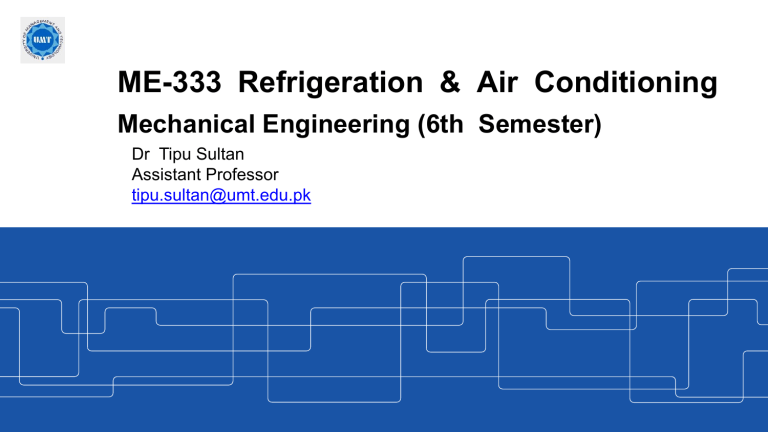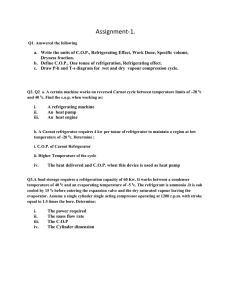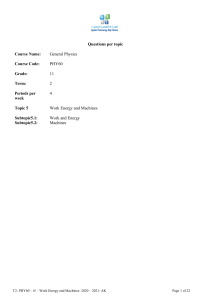
ME-333 Refrigeration & Air Conditioning
Mechanical Engineering (6th Semester)
Dr Tipu Sultan
Assistant Professor
tipu.sultan@umt.edu.pk
2/25/2020
2
Lecture Strategy
Please
1- Smile
3- make your
mobile Silent
2- Respect the
lecture time
3
Text and Reference Books
1.
2.
3.
4.
5.
6.
Principles of Refrigeration (SI Version), By Dossat, R. J.,
John Wiley
Refrigeration and Air Conditioning by J. W. Jones, W. F.
Stoecker McGraw-Hill
Heating and Cooling of Buildings, By Ed. Kreider, Curtiss &
Rabl McGraw-HillApplied
Heating, Ventilating, and Air-Conditioning Analysis and
Design, By McQuiston, Parker and Spitler John Wiley &
Sons
“ASHRAE Handbook” 2009
Handbook of Air conditioning & Refrigeration 2nd Ed. By
Shan K. Wang, McGraw-Hill
2/25/2020
4
Refrigeration and Air-Conditioning
Refrigeration
Process of cooling (extraction of heat) from a
body/object
whose
temperature is already lower than the temperature of its surrondings.
Air-Conditioning
Process of treating air to control simultaneously its
temperature, humidity, cleanliness and distribution in
order to meet the comfort requirement of
occupants of
conditioned space. (Conducive Environement)
2/25/2020
5
Refrigeration and Air-Conditioning
Air-conditioning
Heating,
humidification
and controlhH
of
air quality
Refrigeration
Industrial
refrigeration,
food
preservation
and chemical
processing
Cooling and dehumidification operation
in air conditioning
2/25/2020
6
Some Vocabulary
2/25/2020
7
Heat Engine, refrigerator and Heat Pump
h
Engine Work
WE
E
Q2
Cold body, T1
Q1
Heat Pump
Q1
T1˃Ta
h
Hot body, T2
h
Hot body, T2
Refrigerator
Heat Engine
Hot body, T2
Refrigerator Work
WR
R
Q2
Q1
Pump Work
WP
P
Q2
Cold body, T1
Cold body, T1
T1˂Ta
T1˂Ta
2/25/2020
8
Heat Engines
2/25/2020
9
Heat Engines
• It would be ideal, if all the supplied energy was transferred
into work. Unfortunately, no such transformation process
exist.
• The objective of all the engines or should be to make the
thermal efficiency as near to unity (100%) as possible.
2/25/2020
10
Carnot Cycle
Heat from high
temperature source
Condenser
3
2
Turb
Comp
4
1 Evaporator
Heat to low
temperature sink
Carnot cycle is most efficient possible, because the total
entropy change is zero.
It is a “reversible process”.
2/25/2020
11
Carnot Cycle
2/25/2020
12
Carnot Cycle
• Whenever, a temperature difference exists, motive
power can be produced.
• Carnot’s concept of heat was in error in that, at that time,
heat was thought to have the properties of a fluid which
flows into or out of a body. As a result of this fluid flow, a
body become hot or cold.
• Heat was not considered as energy transfer process.
• However, the suggestion that temperature difference is the
prerequisite of the ability to produce motive power is
correct.
2/25/2020
13
Problem
An ideal engine (Carnot) is rated at 50% efficiency when it is
able to exhaust heat at a temperature of 20 ºC. If the exhaust
temperature is lowered to -30 ºC, what is the new efficiency.
e = 0.585
2/25/2020
14
Second Law of Thermodynamics
• This is a directional law (direction of heat flow)
• Heat transfer can be made to transfer up a gradient but
not without the aid of external energy.
• “Heat cannot flow from a cold body to a hotter body by
itself. Work has to be done in the process.”
2/25/2020
15
Refrigerators
2/25/2020
16
Reversed Carnot Cycle
2/25/2020
17
Reversed Carnot Cycle
Reversing the Carnot cycle does reverse the directions of
heat and work interactions.
A refrigerator or heat pump that operates on the reversed
Carnot cycle is called a Carnot refrigerator or a Carnot heat
pump.
The reversed Carnot cycle is the most efficient refrigeration
cycle operating between two specified temperature levels.
It sets the highest theoretical COP.
2/25/2020
18
Refrigerator
A heat engine operating in reverse is Refrigerator.
Refrigerator Efficiency:
R =
heat out Q2
=
work in W
2/25/2020
19
Refrigerator Efficiency
2/25/2020
20
Heat Pumps
• During the analysis of the refrigeration process, notice that
more energy is rejected at higher temperature than is
required to drive the refrigerator. (COP = COP + 1)
• If the temperature during rejection process is sufficiently
high, perhaps the heat transfer during rejection could be
used in a warming process.
• That, this energy transfer is greater than the energy
required to drive the plant, presents an attractive idea.
• This concept was suggested by Lord Kelvin in 1852.
HP
2/25/2020
Ref
21
Heat Pumps
In Refrigerator the heat removed from low temperature body
(Q2) is the desired effect; while in Heat Pump heat
provided/supplied to high temperature body (Q1) is the desired
effect.
Hence, As Coefficient Of Performance (COP) {In simple terms,
Efficiency} = Output/Input,
For Refrigerator, (COP) = Q2/W.
For Heat Pump (COP) = Q1/W.
2/25/2020
22
Heat Pump
• Many commercial machines have been manufactured
using this process; the evaporator is buried under soil or
suspended in a river or lake.
• But heat pump has not gained wide acceptance as a
heating system.
• It is more complex, more difficult to run and more difficult
to maintain than its conventional counterpart. However, a
decrease in fossil fuel available could encourage its further
development and more widespread use.
2/25/2020
23
Heat Pump and Balance Point
A careful economic analysis is necessary to decide whether a
heat pump is financially viable.
COPHP =
T2
T2 − T1
COPRef =
T1
T2 − T1
&
COPHP = COPRef + 1
The performance of heat pump varies with the temperature of
the source of heat supply as shown in Figures
2/25/2020
24
Heat Pump and Refrigerator
• The heat losses from a building varies linearly with
ambient temperature.
• There is one point “balance point” at which the heat
pump will satisfy the demand.
The balance point is when the system
capacity and load demand are equal.
For further details: Read Chapter 14 of Applied
Thermodynamic By T.D. Eastop and A. McConkey
2/25/2020
25
Balance Point
At a certain temperature - the balance point - the capacity is
equal to the load.
Air-source heat pumps use outside air as the heat source. As the temperature drops,
the capacity decreases. The load demand also increases as the temperature drops.
The balance point is when the system capacity and load demand are equal.
2/25/2020
26
Heat Pump and Refrigerator
• At ambient temperature above the balance point the heat
pump will provide too much heat.
• At temperature below the balance point, supplementary
heating will be necessary to maintain the building at the
required internal temperature.
• A heat pump used for heating is much more effective if the
temperature of the low-temperature source is constant or
approximately constant throughout the heating season,
this is the case if ground water, or a river water, or a lake,
or sea, is used as the source.
2/25/2020
27
What this means to you?
➢ If your system drops below the balance point, it needs
supplemental heat. The balance point for most homes is about
30 degrees.
➢ The balance point of energy efficient homes is lower than that of
homes without proper insulation and other energy efficient
features.
➢ Supplemental heat is only used to boost the system when the
temperature is below the balance point.
➢ Supplemental heat is not auxiliary heat.
➢ Auxiliary heat only comes on when the main system is not
working and needs repair. It is less than the rated capacity for
the system.
2/25/2020
28
Selection Procedure
When you choose a system, the heat pump installer should
explain each of the following:
• The load calculation for your home
• The manufacturer's specified capacity for different outside
temperatures
• Your heat pump balance point chart
• Different types of supplemental heat and which is best for
your home.
2/25/2020
29
Problem
A modern gas furnace can work at practically 100%
efficiency, i.e., 100% of the heat from burning the gas is
converted into heat for the home. Assume that a heat pump
works at 50% of the efficiency of an ideal heat pump.
If electricity costs 3 times as much per kw-hr as gas, for what
range of outside temperatures is it advantageous to use a
heat pump?
Assume Tinside = 295 ºK.
2/25/2020
30
Point to remember ….!
Practically, the reversed Carnot cycle cannot be used for
refrigeration purpose as the adiabatic process requires very
high speed operation, whereas the isothermal process
requires very low speed operation.
2/25/2020
31









